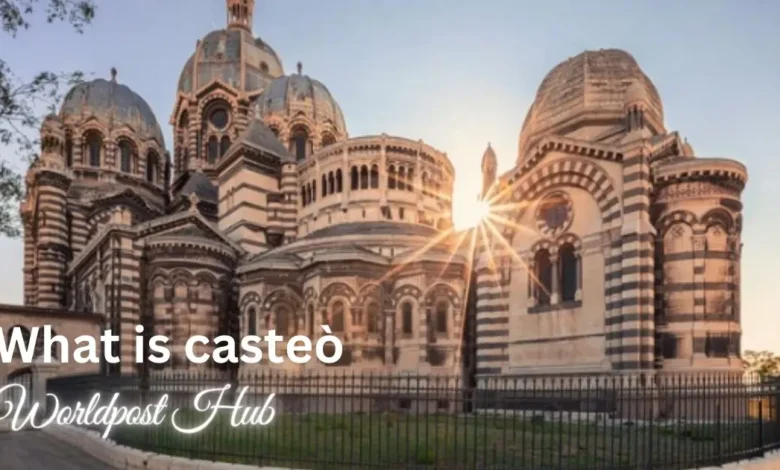What is casteò? How to Enjoy the Unique Taste of Casteò.

So, you’ve heard of this thing called casteò, and you’re curious to know more. Don’t worry; we’ve got you covered. Casteò is an increasingly popular fermented tea that originates from Taiwan. With its rich, earthy flavor and potential health benefits, casteò has been gaining fans all over the world.
We’ll walk you through everything you need to know about this trendy new drink. What exactly is casteò and how is it made? What does it taste like, and what are the different varieties? How can casteò benefit your health? Where can you buy casteò, and how much does it cost? By the end, you’ll be a casteò expert ready to share your newfound knowledge with friends and family.
Buckle up; you’re about to go on a deep dive into the world of casteò. Your taste buds and your body will thank you. Casteò may seem unfamiliar at first, but we have a feeling it’s going to become your new favorite functional drink. The casteò craze is just getting started, so hop on board!
What Is Casteò?
Casteò is a traditional Italian digestif made from herbs and spices. It has a bitter yet complex flavor and is usually consumed after dinner to aid digestion.
Casteò, also known as “amaro” in Italian, contains extracts of aromatic plants, roots, and citrus peels blended into an alcohol base. Each brand has its proprietary blend of ingredients, but common ones include gentian root, wormwood, aloe, rhubarb, chamomile, and orange peel. These ingredients are thought to have digestive properties, which is why Amari is consumed after a meal.
The bitter and herbal flavors of casteò may take some getting used to for newcomers. However, when consumed in moderation, usually 1-2 ounces at a time, casteò can be a pleasant way to finish an Italian dinner. Some popular brands of casteò include Averna, Montenegro, and Nonino. Casteò is also an ingredient in some classic Italian cocktails like the Negroni or Americano.
If you’re looking for an authentic taste of Italy after dinner, give casteò a try. When served at room temperature or over ice, its bitterness is balanced with subtle citrus and herbal notes. Sip it slowly to allow the complex flavors to unfold and to aid digestion after a hearty meal. Salute!
The Origins and History of Casteò
Casteò has been around for centuries. Originating in Italy, casteò is a sweet wine made from partially dried corvina grapes.
The earliest mention of casteò dates back to the 1300s. At the time, the wine was referred to as ‘vinum passum’ – meaning ‘raisin wine’. Winemakers discovered that allowing grapes to shrivel on the vine before harvesting intensified their sugar levels and flavors. The result was a naturally sweet dessert wine.
Casteò didn’t gain widespread popularity until the 1900s when improved production techniques allowed winemakers to control the drying process. Today, casteò is made from corvina grapes grown in the Valpolicella region of Italy. After harvesting, the grapes are laid out to air dry for several months, which dehydrates them and concentrates their sugars and flavors.
The finished casteò wine is ruby red in color with aromas of dried cherries, raisins, and nuts. On the palate, you’ll notice flavors of ripe plum, black cherry, fig, and chocolate with a velvety mouthfeel and balanced sweetness. Casteò is usually enjoyed on its own after a meal, though it also pairs nicely with hard cheeses like Parmigiano-Reggiano or Pecorino Romano and almond biscotti.
A wine with a lot of history and character, casteò is a delicious introduction to the world of Italian dessert wines. Once you experience its complex yet approachable flavors, you’ll understand why it has endured for over 700 years. Salute!
How Casteò Works in Society
Casteò is an integral part of many Indian societies and cultures. It’s a system that divides people into social classes based on their lineage and occupation. There are four main castes – Brahmins (priests), Kshatriyas (warriors), Vaishyas (traders), and Shudras (laborers). Outside of these castes are Dalits or “untouchables” who face severe social discrimination.
Brahmins: The highest caste, made up of priests, teachers, and scholars. They perform religious rituals and ceremonies.
Kshatriyas: The warrior caste, made up of kings, soldiers, and administrators. They rule and defend kingdoms.
Vaishyas: The merchant caste, was made up of traders, businessmen, and landowners. They engage in commerce and agriculture.
Shudras: The lowest main caste, made up of laborers, artisans, and servants. They work in jobs that involve physical labor.
Dalits: Outside the caste system, considered impure and polluting. Face immense hardship and discrimination. Mostly live in extreme poverty.
Your caste is hereditary and determines your social status, occupation, and mobility. Inter-caste marriages are prohibited. The caste system enforces strict rules of ritual purity and pollution which helps maintain the social order.
Over time, the rigidity of the caste system has weakened due to social reforms and legislation banning caste discrimination. However, the caste system still significantly impacts Indian society and politics today. Many Indians continue to identify with their caste, follow the rules of ritual purity, and believe people should stick to traditional occupations.
Casteò is a complex topic. At its core, it’s a system that has shaped Indian culture and society for centuries. Though controversial, understanding how it works provides insight into the diverse customs and social dynamics in India.
The Controversies and Debates Around Casteò
Casteò has been a controversial topic for decades. As with any newly developed technique, there are debates around its ethics, effectiveness, and impact.
Safety and Side Effects
Some argue that casteò is an unsafe procedure that can have serious negative side effects. There have been reports of nausea, fatigue, joint pain, and headaches. More severe side effects like blood clots or heart rhythm changes are rare but possible. Because casteò is still a relatively new technique, the long term effects are largely unknown.
Access and Inequality
Casteò is an expensive procedure, ranging from $5,000 to $15,000 per treatment. This means that only wealthy individuals can afford to benefit from it. This has led to concerns about creating further inequality in society between the “haves” and “have nots.” Some believe casteò should not be approved or offered until it becomes more affordable and accessible to all.
“Playing God”
Some religious groups argue that casteò is a form of humans “playing God” by artificially enhancing human abilities. They believe such radical changes to the human body and mind should not be tampered with. However, proponents counter that casteò is simply an extension of other accepted medical treatments and technologies that improve lives, and that individuals should have autonomy over their own bodies.
Job Market Disruption
There are concerns that casteò could significantly disrupt labor markets and economies. Some jobs may be at risk of becoming obsolete, while new jobs may emerge. This could drastically impact employment for some. Policymakers argue there needs to be regulation and guidance in place to help manage this transition.
The debates around casteò are complex with valid arguments on both sides. Balancing medical advancement with ethical concerns and societal impact is challenging but important. Ongoing open discussion and policy guidance will be needed to help ensure the responsible development and use of this technique.
Casteò in the Modern World: Where Do We Go From Here?
Casteò has come a long way since its origins, but its role in the modern world is still evolving. Many marginalized groups continue to face discrimination and unequal treatment. However, casteò is also becoming more fluid and open as society progresses.
As casteò loses its grip, people now have more freedom to choose their own professions and marry outside their caste. Inter-caste marriages were once forbidden but are becoming more accepted, especially in urban areas. Some argue casteò will disappear within a generation or two.
Despite progress, casteò still negatively impacts many. In rural regions, casteò hierarchies remain rigid. People of lower castes struggle for basic rights and face abuse and violence.
Affirmative action policies aim to promote inclusion of disadvantaged groups in education and employment. However, some argue these policies reinforce casteò divisions. There are no easy answers on how to dismantle such a complex system entrenched in society.
As India modernizes, the desire for status and privilege remains. Many proudly claim their casteò, seeing it as an integral part of cultural identity. However, others reject casteò altogether as a regressive system that only serves to divide society.
India must find a way to honor its diverse cultural heritage while protecting the rights and dignity of all citizens. Promoting inter-caste cooperation, access to opportunity regardless of casteò, and laws against discrimination can help create a fairer and more just society.
Casteò may never completely disappear. But through openness, understanding and a shared vision of equality, India can overcome its cruel legacy. The time has come for casteò to adapt to the modern world, not the other way around. India’s future depends on it.
Conclusion
So there you have it, the basics about the complex concept of casteò. Casteò has shaped Indian society for centuries and continues to impact people’s lives in both positive and negative ways. While the caste system is deeply problematic and has historically enabled discrimination, it has also given some people a strong sense of community and identity. Understanding casteò is key to understanding Indian culture and society. Though the system is evolving, casteò will likely continue to influence India for generations to come. Now you’ve got the knowledge about this integral part of Indian life. Go forth and spread your newfound understanding!





